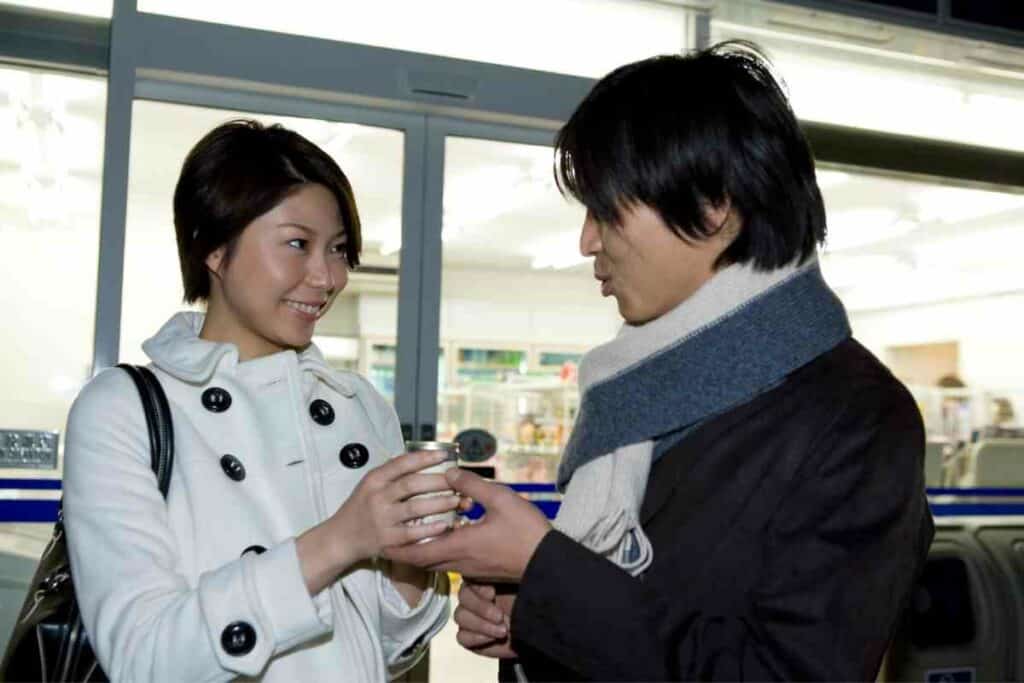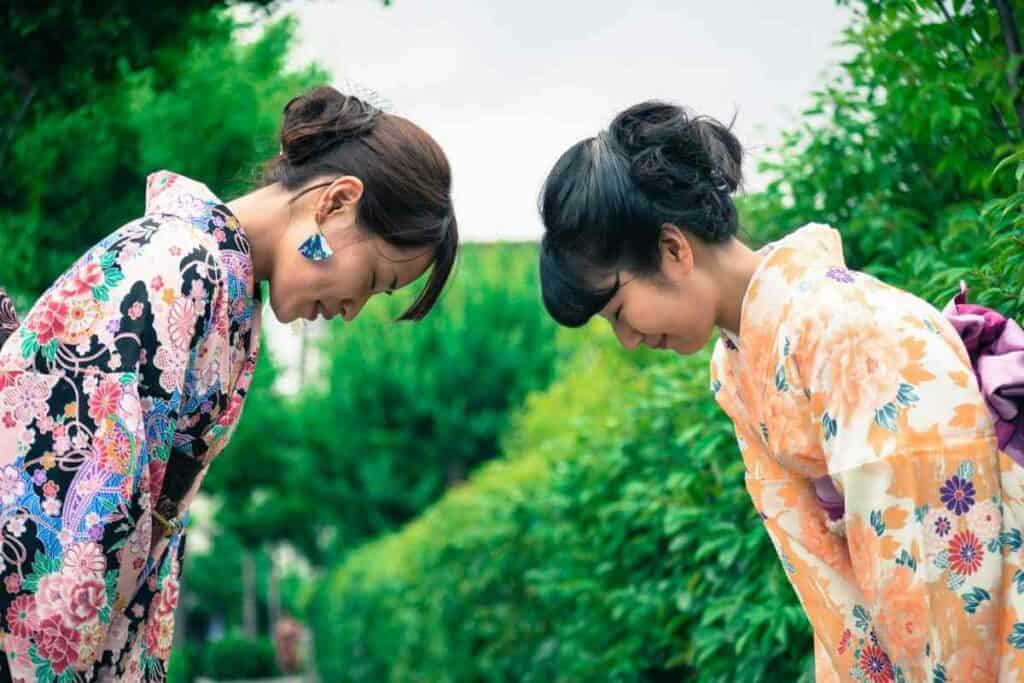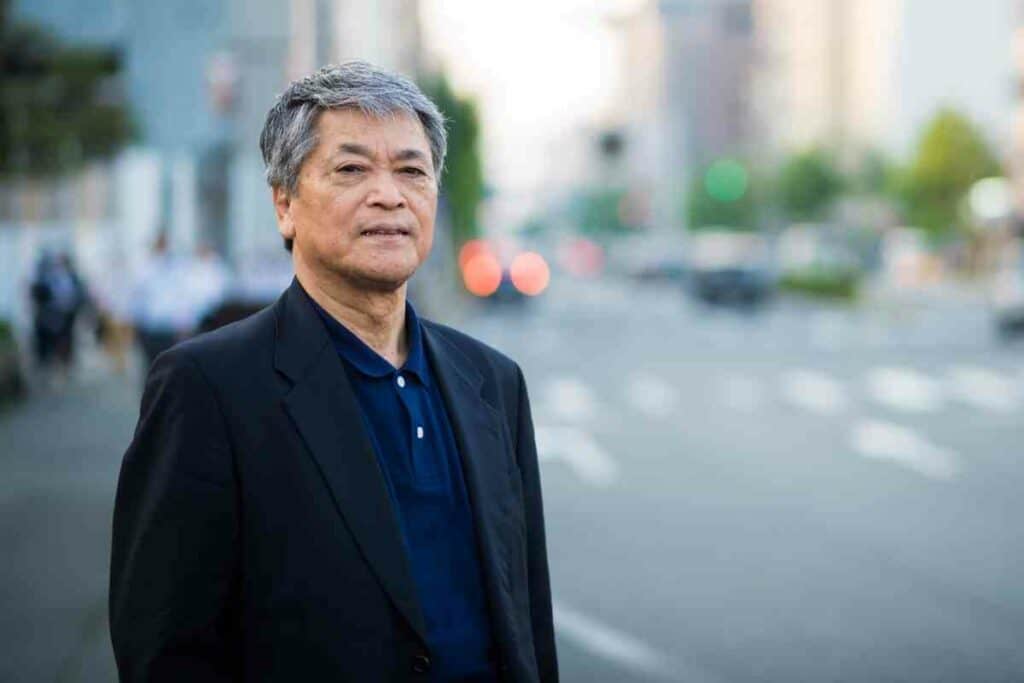In Japan, there is a huge emphasis on nonverbal communication.
Words, of course, are important, but nonverbal Japanese communications like gestures, facial expressions, tone of voice, body language, and sounds (non-words) are of equal importance.
This concept of nonverbal communication in Japan is called haragei.

Conversely, in the West, most people rely on words to communicate everything. We expect clear and precise verbal communication.
When we don’t get this, many of us struggle. Westerners typically value those who are good at presenting ideas and debating and discussing points.
When we go through our education, we are taught these skills from a young age, and when we enter the world of work, we’re expected to hone these skills.
Table of Contents
Haragei
The interpersonal communication concept of haragei literally means “stomach art”.
It refers to how one exchanges feelings and thoughts implicitly in conversation.

Haragei is a type of rhetoric, through which one can express true meaning and real intention through implication.
In many situations and societies, good haragei is also a sign of a strong personality and charisma.
When negotiating, we see haragei as:
- indirect and vague statements
- euphemisms
- avoiding comments
- and prolonged silences
Things are communicated through facial expressions, emotional contexts, and timings instead of direct speech.
This is also classed as a way of leading, which is very different from leadership styles in the west.
Instead of giving subordinates direct orders, there are lots of subtle nonverbal communications. Doing this well is a desirable leadership trait.
Booking.comWhy do the Japanese rely on nonverbal communications?
It is believed that a reason for Japanese reliance on nonverbal communication is due to a high level of shared history, according to scholars.

In Western families, for example, we might communicate nonverbally when we know people really well – like with our parents, partners, and siblings.
A simple raise of the eyebrow can communicate a lot when you know someone well.
Well, this is how all Japanese people communicate with one another.
In Japan, the people describe their style of communication as ichi ieba ju wakaru, which means ‘hear one, understand ten.’
To Explain – This means that a speaker might say 10% of what they mean, and that the other person will understand the remaining 90% based on nonverbal communications. For westerners, this can be confusing as we’re used to hearing 100%.
How can westerners draw out meaning when they don’t understand nonverbal Japanese communications?
It’s difficult to learn and understand Japanese nonverbal so westerners might need to do a little gentle prodding to ask for more information or an explanation.
Essentially, this involves asking follow-up questions like:
- “please provide more information about …”
- or “May I have some more background information about this?”
You can also ask things like “I’m just checking I have understood, do you want …?” or “could you advise me on this situation please?”.
If you don’t ask a follow-up question, the person will presume you have understood 100%.
Haragei in business

If you’re traveling in Japan on business, it’s important to understand nonverbal Japanese communications.
Japan is an important country in the global economy and understanding nonverbal communications is important for international relations and deals.
Examples of nonverbal Japanese communications
To help you understand more about nonverbal Japanese communications, here are some examples.
Greetings in Japan
In Japan, it is a sign of respect to greet someone with a bow.
People will bow to those they hold in high regard like teachers, elders, and others with high status. The person returns the bow in gratitude.
It’s not uncommon for businessmen and women in Japan to do a handshake but it won’t be strong and there won’t be eye contact.

Whilst strong eye contact is a positive trait of confidence in the Western world, in Japan it is a challenge – and can even be seen as disrespectful.
The bow is the only full-body gesture in Japanese culture and many variations of the bow exist.
Keep In Mind – A deep bow is used to apologize, a medium bow would be used in the likes of a job interview, and a short head nod would be used to greet co-workers, for example.
It can take a while to master the different types of bows with lots of angle variations and variations to hand placements too.
Silence
When Japanese people listen, they might nod to show they are paying attention.
There isn’t a lot of idle chat, though. There is no requirement or urge to fill any silence. Silence is used to consider the discussion and is not felt as awkward.

When talking to Japanese people, especially in a business setting, it’s important to leave silence so that you aren’t just talking non-stop.
Being too verbose will come across as hard to understand as well as showing you’re not good at being subtle.
Posture
Another Japanese nonverbal communication is the way a person holds themselves.
Japanese people consider sitting slouched or with your legs crossed as rude. You should instead sit upright and have both feet firmly on the floor.
When in a standing position, you should provide others with enough personal space so that you’re not too close to them.
Be sure to control your emotions

When someone shows emotions in Japan, it is considered to be the other person’s burden.
Typically, Japanese people remain passive when they speak. Negative emotions are expressed with a short inhalation or a head tilt.
Understanding the hierarchical culture
Business culture in Japan is hierarchical.
This influences your seating position in a room and who you can communicate with.
The most important person will sit in the seat that is furthest away from the entrance.
Gift giving
In Japan, gifts are often given when an event or meeting ends.
The gift’s presentation and how it is handed over are just as important as its contents.
Gifts are only ever opened in private.
Kinesics and Proxemics in Japan
When we talk of kinesics, we’re referring to the Japanese culture of nonverbal communication.
In Japan, it is essential to interpret and understand body language. In doing so, you avoid embarrassing or unpleasant situations and gain respect.
Eye contact is also considered aggressive and rude. It is seen as impolite if you maintain direct eye contact with a person who is superior.

You can show respect to someone by not using eye contact. When you’re in a crowd (which is common in Japanese cities), not giving eye contact is how you give people privacy.
A lot of Japanese people will look towards your neck to avoid giving eye contact.
Similar to kinesics, proxemics is all about theories and observations of culture. It refers to space – public, social, personal, and intimate.
Since Japanese cities are dense in terms of their population, there is very little personal space.
This has led to lots of Japanese people being introverted, withdrawn, and shy. It can be said, therefore, that Japan’s demographics have influenced Japanese proxemics.
Japanese Gestures to Learn

We’ve discussed the bow further up so in this section, we’ll look at other gestures you can learn to appear more ‘Japanese’.
Firstly – When a Japanese person is talking about something, they often replace its name with the word “that” or “this” and gesture towards it with their hand.
The only thing to bear in mind here is that you shouldn’t use an index finger. Pointing in this way would be too direct.
Instead – Use open hands and point your fingers to the person or place. Strangely, though, you can use your index finger when pointing to yourself.
Another thing to consider is hand placement.
At work or when being neutral, women usually place their hands in front of their bodies, while men will keep theirs behind.
In a casual setting, you could cross your arms. Unlike in Westernized culture, this isn’t seen as defensive, rather it is a sign you’re thinking or paying attention.
Facial Expressions

Japanese will use facial expressions only for a simple emotion like:
- surprise
- anger
- happiness
- or ambivalence
You won’t really see emotions like frustration or disgust showing up on faces as these are likely to be understood by words used instead of up-turned lips or furrowed brows.
It’s quite common to talk to people who are going through huge emotional turmoil who manage to keep the same expression.
The only way of knowing how they feel is by picking up on little inflections in their tone of voice.
Final thoughts on nonverbal Japanese communications
Japanese culture is so fascinating when it comes to communication and there is a steep learning curve for foreigners visiting Japan.
When trying to understand nonverbal Japanese communications, the most important thing is to remember they exist so that you look for them.
It will take a long time to pick up on the subtleties of how Japanese people communicate so don’t be disheartened when you’re at the beginning and getting confused.
The most important things to remember are to ask questions to clarify understanding and learn the gestures to show respect first and foremost!
Also Read
- 12 Things Tourists Should NEVER Say in Japan
- Kissing Robot: Exploring the Popularity of the Chinese Kissing App
- Unlocking the Secret Dating Rituals Only Locals Know in Japan
- Samurai Armor: Ancient Protection for Japan’s Elite Warriors
- 10 Amazing Facts About Schools in Japan: Unique Traditions and Educational Practices
- Where can you see snow monkeys in Japan: Best locations and viewing tips









